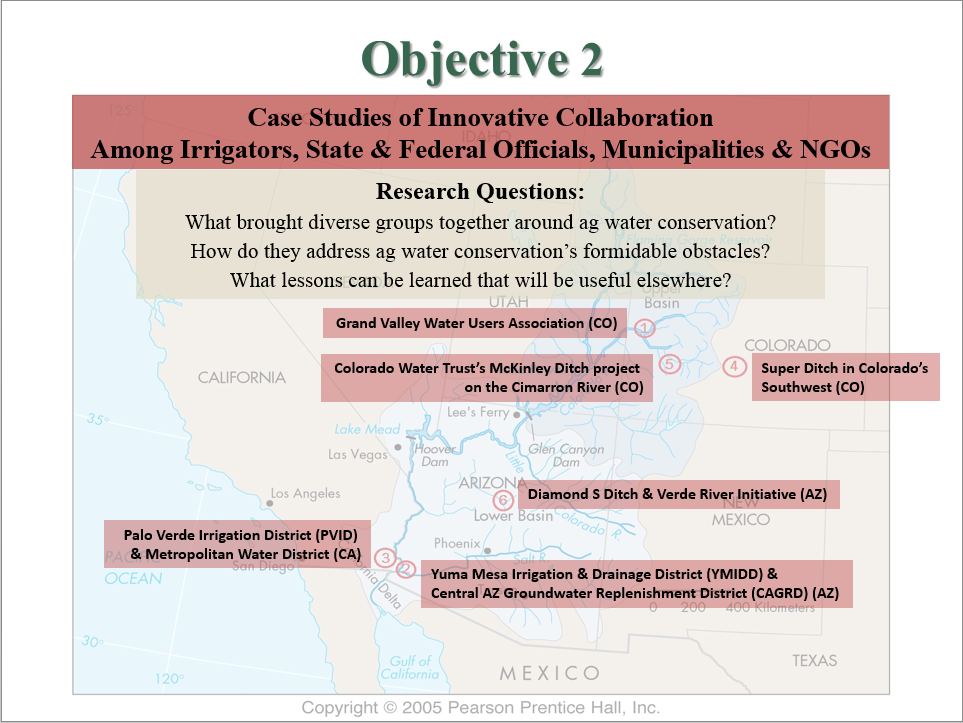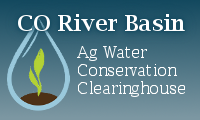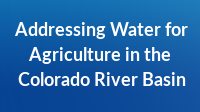
Identify Barriers & Opportunities

The purpose of Objective 2 was to qualitatively document and analyze the legal, economic, and social barriers related to the adoption of methods to conserve irrigation water in the CRB. The social science analysis associated with Objective 2 aimed to discover what factors a range of key stakeholders in agricultural water conservation (agricultural irrigators; municipal water suppliers; environmental organizations; and federal and state water agencies) see as determining their conservation-related decisions; what changes they see as necessary to make agricultural water conservation more appropriate and viable; and how they see their relationship to other water users' efforts to find new water sources for future expected CRB needs. This latter question is key to enlisting the active support of agricultural water users and other water interest groups in generating new water sources for expected supply gaps in the CRB.
Using social science primary and secondary literature and field research methods, we systematically analyzed the diverse frameworks of incentives and disincentives shaping agricultural producers' decisions to engage or not engage in agricultural water conservation. We reviewed secondary academic and technical literatures related to agricultural water conservation. We carried out more than fifty semi-structured in-depth face to face and telephone interviews with a structured sample of producers involved in six cases of multi-stakeholder collaboration for agricultural water conservation for multiple purposes, and visited those projects in three CRB states: Colorado, Arizona and California.
The six case in-depth case studies encompassed three types of experience with collaboration for agricultural water conservation: between irrigators and environmentalists; irrigators and municipal water suppliers; and irrigators and government agencies. The six case studies were the following.
In Colorado: 1) the Grand Valley Water Users' Association's collaboration with federal agencies and other stakeholders for conservation and efficiency benefitting endangered fish species and for managing river flows for multiple purposes; 2) development in Colorado's southeastern region of the virtual "Super Ditch" to manage temporary leasing of agricultural water for municipal use; 3) the Colorado Water Trust's McKinley Ditch project to generate water from split season irrigation agreements and delivery efficiency improvements for instream flows.
In Arizona: 4) the Yuma Mesa Irrigation and Drainage District-Central Arizona Groundwater Replenishment District pilot fallowing program to generate saved system water for Lake Mead; 5) The Nature Conservancy's work with local farmers on the Diamond S Ditch and elsewhere on the Verde River to improve environmental flows.
In California: 6) the Palo Verde Irrigation District's fallowing program in collaboration with the Metropolitan Water District.
In face-to-face and telephone interviews and in field visits to these collaborative experiences, we studied what brought diverse groups together around agricultural water conservation; how they surmounted or sought to surmount conservation's formidable obstacles; and what lessons from their experiences may be useful elsewhere in the Basin. Participants in these six collaborative experiences have implemented a range of fallowing, market leasing, shared infrastructure investment and other mechanisms to conserve agricultural water that can then be used for multiple uses while continuing to benefit irrigators.
The social science research associated with Objective 2 has:
1) Developed a preliminary framework for identifying and assessing enabling hydrological, legal and social structural conditions that can help surmount barriers to agricultural water conservation and may, with appropriate support, facilitate multistakeholder collaboration around agricultural water in diverse local contexts.
2) Identified and analyzed key legal and socio-economic barriers to agricultural water conservation in six case study regions. Legal barriers include the potential loss of rights to conserved water through abandonment, the need to ensure irrigation return flows to junior users, the legal hazards of navigating water use changes, and the challenge of "shepherding" conserved water to its intended beneficiaries. Socio-economic barriers include irrigators' perception that they are "under siege" with "targets on their backs" in a context of unequal power and unclear or non-existent economic benefits from conserving agricultural water. Cultural barriers include resistance against apparent external threats to local communities and ways of life; uncertainties created by a lack of knowledge about water conservation; and differences in how diverse users value water and define conservation.
3) Identified and analyzed key enabling hydrological, legal and social conditions in six case study regions that may facilitate locally appropriate and effective multi-stakeholder collaboration around agricultural water conservation. Facilitating hydro-social conditions include favorable location of junior water users with legal rights to return flows; the ability of senior water rights holders to "shepherd" conserved water, and the existence of powerful upstream and downstream water users. Facilitating legal conditions include enabling state-level regulatory legislation; supportive frameworks for flexible water use changes and transfers; instream flow statues; and irrigator water rights that are structured in ways that support collaboration. Facilitating social conditions include external regulatory and political "push" factors that encourage irrigators to consider collaborating with other water users; the existence of multiple benefits for participants in collaboration; diverse water users' view that water conservation represents a community as well as agricultural issue; and users' overlapping or compatible definitions of water conservation.
Summary of key findings of Objective 2
Agricultural water conservation collaboration will not make sense for irrigators and other water users in all situations, especially in the CRB's complex water governance environment where indeed, "every ditch is different." There is almost certainly no single recipe for successful agricultural water conservation and collaboration in the CRB. However, our research suggests that agricultural water conservation may be possible more often than widely assumed. Under the right conditions, agricultural water conservation can preserve agricultural security while temporarily freeing up water for other uses, in ways that benefit multiple parties.
This research has developed a preliminary analytical framework for identifying and assessing the hydro-social, legal and social structural conditions in which multistakeholder collaboration can make sense and produce positive outcomes in diverse local settings. This framework can help identify conditions under which agricultural water conservation collaboration may already be occurring, as well as where it might potentially be developed. It can also highlight where external support might be fruitfully dedicated, to take advantage of conditions under which agricultural water conservation may be supportive of agricultural water security while making water available for multiple purposes.



